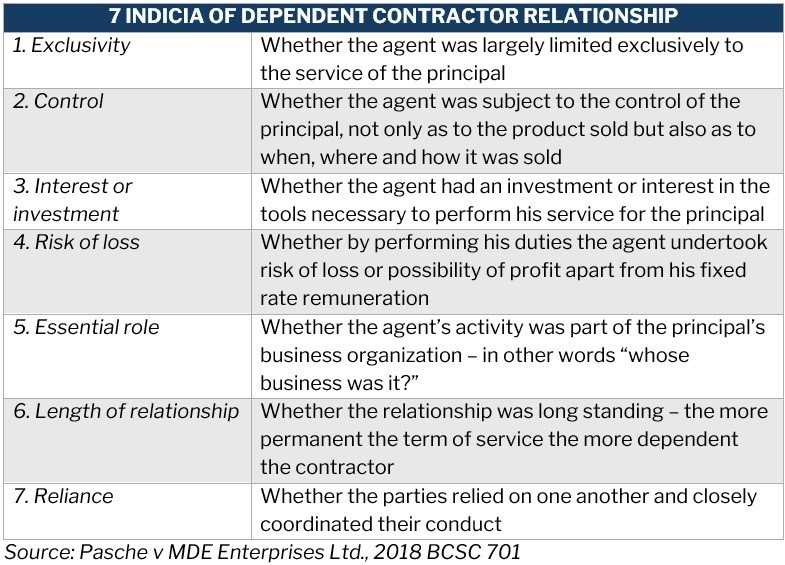How do you determine if a worker is a dependent contractor? An employment law expert analyzes recent court decisions to get answers

Employers are generally familiar with the distinction between employees and independent contractors. But a third category of workers — “dependent contractors” — has become more widely recognized over the past decade.
In this article, Canadian HR Reporter delves deeper into this worker classification. We will explain what differentiates dependent contractors from other types of workers to help you avoid the legal pitfalls of misclassification. We also turned to an employment law expert, who looked at recent legal decisions to find out how courts decide on whether a contractor is dependent or independent.
If you’re an employer doing business with different classes of workers, this guide can prove handy. Read on and learn more about dependent contractors and their rights and entitlements in this article.
What does it mean to be a dependent contractor?
A dependent contractor falls on the spectrum between an employee and an independent contractor. Just like employees, dependent contractors often rely on a single client for a huge chunk of their earnings. But just like independent contractors, they are considered self-employed and have the freedom to offer their services to multiple clients.
Consider the case of Ramon, a freelance writer, who operates as an independent contractor. Ramon serves various clients. On average, however, he gets between 65% and 75% of his income from a specific company that contracts him consistently for different writing projects.
While not technically an employee, Ramon is economically dependent on this company. If his contract with this client ends, he would experience a big financial hit. Given this, Ramon can be considered as a dependent contractor.
By contrast, an independent contractor who relies on this company for around 10% of their income will experience a more modest loss if their contract ends.
George Green, partner at McKercher LLP, defines a dependent contractor as a “contractor who is economically dependent on their principal.” He adds that this status is not limited to individuals. Any contracting entity – including a corporation – can be found to be a dependent contractor.
“When evaluating whether a dependent relationship exists, courts will look behind written agreements to determine the relationship’s true nature,” he said. “How the parties labelled their relationship is not determinative.”
The rights of dependent contractors generally fall between those of employees and independent contractors. Principals must provide dependent contractors with reasonable notice of termination of their contract or payment in lieu of reasonable notice.
“The amount of notice or payment depends on the circumstances, but it will likely be less than those found in employer-employee relationships, with similar time frames, compensation, prospects for reemployment, or replacement work,” said Green.
“Although the legal concept of a dependent contractor has yet to be formally recognized by all Canadian jurisdictions, nationwide recognition is likely inevitable. Further, dependent contractor status can be determined by the courts and applied retroactively, as long as claims are commenced within the relevant limitation periods.”
Find out the differences between an employee and a contractor in this legal analysis.
Determining whether a contractor is dependent or independent: Case analysis
According to Green, recent developments in evaluating whether a contractor is dependent or independent might become based largely on one key factor: exclusivity.
“Courts in several Canadian jurisdictions have grappled with how to differentiate between dependent contractors and independent contractors by setting out a litany of factors or tests to be considered,” he said. “These are not always consistent, even within the same jurisdiction.”
Here’s the employment law expert’s analysis of some of the cases that delved into the question of whether a contractor is dependent or independent.
Recent decisions on dependent contractor relationship, British Columbia
The British Columbia Supreme Court in the 2018 Pasche v. MDE Enterprises Ltd. referred to seven “indicia of a dependent contractor relationship.”

The same court in the 2019 Liebreich v. Farmers of North America referred to four tests that can be further divided into 12 factors.

*The factors determining the company’s level of control over the worker’s activities include:
- company's power to select or not select the worker
- payment of wages
- control over the method of work
- company's right of suspension or dismissal
The latter case appears to adopt an all-encompassing approach to determining whether a worker is an employee, dependent contractor, or independent contractor. But without direction from the British Columbia Court of Appeal, it is not clear which factors or tests are preferable.
Recent decisions on dependent contractor relationship, Ontario
The Ontario Court of Appeal is the only Canadian appellate-level court to directly engage in recent years the complexities surrounding dependent contractors. In its most recent decisions, the Ontario Court of Appeal suggests that exclusivity is the key factor.
Thurston v. Ontario (Children’s Lawyer)
In the 2019 Thurston v. Ontario (Children’s Lawyer), the appeal court found that exclusivity does not restrict the contractor to only one client (meaning the principal in question). “Near-complete exclusivity” would suffice, but to be considered a dependent contractor, “substantially more than 50%” of the contractor’s income must be earned from that principal.
Turning to the facts of the case, Barbara Thurston was a lawyer who provided legal services to the Office of the Children’s Lawyer (OCL) for over 13 years in a series of fixed-term contracts. These contracts were not automatically renewed. Thurston had to apply for a new contract each time. Thurston’s work for the OCL accounted for between 14.8% and 62.6% of her independent legal practice’s annual earnings. The average was 39.9%.
When the last contract expired in 2015, Thurston was denied a new contract. She then brought a claim for 20 months’ notice of termination on the basis that she was a dependent contractor.
The Court of Appeal concluded that Thurston was not a dependent contractor and listed multiple considerations in support, such as the OCL not guaranteeing a minimum amount of work for Thurston.
Ultimately, however, the Court of Appeal’s conclusion was based on exclusivity: “The key point is this: Only 39.9% of [Thurston’s] earnings came from OCL during the relevant period. This cannot reasonably be categorized as a ‘near-exclusive’ relationship.”
While losing the OCL as a client resulted in a significant reduction in Thurston’s earnings, this reduction did not mean Thurston was a dependent contractor, said the court.
Cormier v. 1772887 Ontario Limited c.o.b. as St. Joseph Communications
In the 2019 Cormier v. 1772887 Ontario Limited c.o.b. as St. Joseph Communications, the Ontario Court of Appeal reinforced the importance of exclusivity. The principal appealed the lower court’s finding of a dependent contractor relationship and argued that the lower court erred by focusing on exclusivity, rather than whether the contractor was economically dependent upon the principal.
The Ontario Court of Appeal rejected this argument and interpreted the lower court’s decision contextually. It found that the lower court had concluded that the contractor was in an exclusive relationship and was economically dependent on her principal.
It is difficult to imagine a situation where a contractor who works exclusively (or nearly exclusively) for one specific principal is not economically dependent on that same principal.
Beattie v. Women’s College Hospital
Parties should not automatically assume that dependent contractor status necessarily means damages will be awarded where no notice of termination was provided.
Dependent contractors can be subject to jurisdiction- or industry-specific legislation that can lead to possibly unforeseen results.
For example, in the 2018 Beattie v. Women’s College Hospital, the Ontario Superior Court of Justice found that the doctors met the criteria for dependent contractor status but concluded that the Public Hospitals Act prevented them from recovering damages in lieu of reasonable notice of termination.
The doctors had practised medicine in urgent care for decades when the hospital decided, in good faith, to close the centre. The statute explicitly barred all actions against the hospital for such decisions. This decision was affirmed by the Ontario Court of Appeal, and the Supreme Court of Canada refused leave to appeal.
Find out the top employment lawyers and law firms in Canada and in your jurisdiction by checking out latest Lexpert Rankings.
How can employers avoid the legal pitfalls of worker misclassification?
In light of the recent Ontario Court of Appeal cases, Green advised employers and principals to proactively address the potential risk of independent contractors being found to be dependent contractors.
“The longer this risk is ignored, the higher the potential damages could be,” he said. “Addressing this risk is often difficult. Consider how a principal could identify which of its contractors are dependent or independent. Does it know what percentage of the earnings (both annually and on average) are attributable to its business?
“If not, perhaps a solution is to revise the standard contractor agreements so that contractors must provide this information annually. This information can then factor into a principal’s assessment of risk and whether it wishes to continue to provide such substantial amounts of work to one single contractor. Naturally, this solution carries its own legal and business challenges.”
Misclassifying a worker comes with legal and financial consequences – something that’s preventable with the help of an experienced employment lawyer. If you’re looking for a legal expert to guide you, our list of 5-Star Employment Lawyers is the place to go.
The employment lawyers and law firms featured in our special reports have been nominated by their peers. They were also vetted by our panel of experts as trusted and dependable industry leaders. These firms and professionals are fully capable of helping you navigate Canada’s dynamic labour environment.
Do you have experience involving dependent contractors that you want to share? We’d love to see your story in the comments.




